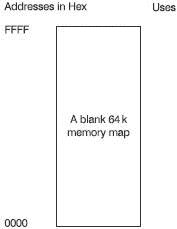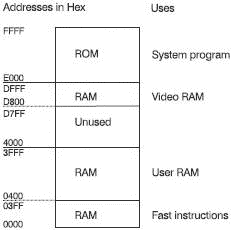Книга: Introduction to Microprocessors and Microcontrollers
Memory maps
Memory maps
A microprocessor has a number of address lines that can be used to access RAM or ROM or other devices within the system. As we saw in the memory chips, the total memory addressable by a microprocessor is found by the formula 2nwhere n is the number of address lines. For example, an 8-bit microprocessor generally has 16 address lines and can access 216 or would have 65 536 or 64 bytes of memory. The Digital Alpha 21064 has 34-bit address lines giving 234 or a little over 17 Gbytes. This memory is shared between the RAMs, ROMs and other devices, including some for the microprocessor itself to use.
The system designer has to decide in what way the available memory is to be used. Using the memory map of the 8-bit microprocessor as a simple example, we start off with a blank space as in Figure 6.21. When the microprocessor is first supplied with power it will immediately start following the first program provided. How does it know what program is first? The answer to this is that it goes to a predetermined address, which has been built into the microprocessor during manufacture.

Figure 6.21 The starting point for a memory map

Figure 6.22 A typical small system memory map
If we assume the startup address is FFFAH, then we must put some useful information at that address for it to follow. This implies that some ROM memory must be at the top end of the memory map. Most provide some extra fast programming ability and this usually requires that some RAM to be available at the bottom end of the memory map.
There is nothing else that is allocated to any particular address so any other RAM and ROM memories can be placed at any position on the map. The map does not have to be full, indeed it seldom is. The balance between RAM and ROM depends on the purpose to which the system is to be put. A control system running a piece of manufacturing machinery is likely to be predominately ROM whereas a computer would need significant RAM. A simple memory map is shown in Figure 6.22.
Sorting out the addresses
This is just an exercise in hex numbers in which a ‘hex’ calculator will prove invaluable. Now, 1 kbyte of memory occupies 210 or 1024 locations, which is 400H in hex. The first section of RAM extends from: start address + highest RAM address = 0000H to 03FFH so the highest address in the ‘Fast instructions’ section is 03FFH. The User RAM extends from 0400H to 3FFFH. How many kilobytes of memory is this?
This is 15 kbytes of memory. This was found by subtracting 0400H from 4000H to give 3C00H and then dividing this result by 400H, the hex equivalent of 1 kbyte. The division is best done by calculator. Remember that the fact that the user-RAM ended at 3FFFH means that the total number of locations, including the first one in 4000H so it was more convenient to use the figure of 4000H straight from the memory map. This is sometimes a little difficult to fully come to terms with, but a cup of coffee and a slump in an armchair often helps.
In a similar way, the video RAM that holds the information to be displayed on a monitor can be found by subtracting the lower address D800H from the higher address E000H to give 800H. Dividing by 400H indicates 2 kbytes of video RAM.
Example
If a 12 kbytes block of ROM started at the address 8000H, what is the highest address in the ROM?
Since 1 kbyte = 1024, it follows that 12 kbytes = 12?1024 or 12 288 in denary. Converting this to hex gives 3000H. Now, we have to be a bit careful. If the ROM includes 3000H addresses, they will run from 0 to 2FFFH. Adding the start address of 8000H to the highest address will give 8000+2FFF=AFFFH, which is the highest address in the ROM.
- A flip-flop or bistable
- A register
- Shift registers
- Rotate registers
- Memories
- RAM
- Accessing memory
- Two types of RAM
- Memory organization
- Three types of ROM
- Pin layout of an EPROM
- Pin layout of a SRAM
- Pin layout of a DRAM
- Some more memories that don’t fit into the general pattern
- Memory maps
- Quiz time 6
- EVENT MEMORY SIZE
- 12.2.1 Port-Mapped vs. Memory-Mapped I
- Displaying Free and Used Memory with free
- 2.3.1. Flash Memory
- 2.3.5. Memory Space
- 2.3.7. Process Virtual Memory
- 9.3. MEMORY MANAGEMENT IN CHORUS
- 1.3.10 EEPROM Data Memory
- 2.1.1 Program Memory Organization
- 2.1.2 Data Memory Organization
- 6 Distributed Shared Memory
- 6.2. WHAT IS SHARED MEMORY?




